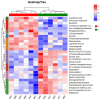Effects of Modified Attapulgite on Daily Weight Gain, Serum Indexes and Serum Metabolites in Fattening Beef Cattle
- PMID: 40804957
- PMCID: PMC12345580
- DOI: 10.3390/ani15152167
Effects of Modified Attapulgite on Daily Weight Gain, Serum Indexes and Serum Metabolites in Fattening Beef Cattle
Abstract
In this study, we investigated the effects of dietary supplementation with thermally modified attapulgite on the daily weight gain, serum biochemical indices, and serum metabolites of Simmental fattening cattle. A total of 30 healthy Simmental fattening beef calves of similar age (8 to 9 months old) and body weight (370 ± 10 kg) were randomly divided into two groups, each containing 15 animals. A control group was fed the basal diet, and a treatment group was fed the same basal diet with the addition of 4 g/kg of thermally modified attapulgite. After 75 days of formal experiment, the calves in the two groups were weighed, and blood samples were collected by tail vein blood sampling for determinations of the serum biochemical indices and serum metabolites using liquid chromatography-mass spectrometry (LC-MS) analysis. The results indicated that the addition of thermally modified attapulgite to the diet had no significant effects on the daily weight gain of fattening beef cattle. After feeding with modified attapulgite, the glutathione peroxidase and superoxide dismutase activities in the serum of the experimental group were 55.02% (257.26 U·mL-1 to 165.95 U·mL-1, p < 0.05) and 13.11% (18.98 U·mL-1 to 16.78 U·mL-1, p < 0.05) higher than that in the control group. Compared with the control group, the tumor necrosis factor-alpha content was reduced by 14.50% (31.27 pg·mL-1 to 36.57 pg·mL-1, p < 0.01), and the concentration of interleukin-6 and lipopolysaccharide decreased by 17.00% (34.33 pg·mL-1 to 41.36 pg·mL-1, p < 0.001) and 23.05% (51.34 EU·L-1 to 66.72 EU·L-1, p < 0.001) in the serum of the experimental group. Contrastingly, the thermally modified attapulgite had no significant effects on the levels of serum total protein, albumin, or globulin in Simmental fattening cattle (p > 0.05). Furthermore, the results of serum metabolomic analyses revealed that there were a total of 98 differential metabolites, which were mainly enriched with respect to glycerophospholipid metabolism, Th1 and Th2 cell differentiation, autophagy-other, retrograde endogenous cannabinoid signaling, and the NF-κB signaling pathway. Overall, thermally modified attapulgite was found to effectively increase the activity of antioxidant enzymes, reduce serum inflammatory mediators, may suppress oxidative damage, enhance immunity, and have a positive influence on the health of Simmental fattening beef calves.
Keywords: antioxidant indicator; fattening beef cattle; inflammatory factor; modified attapulgite; serum metabolism.
Conflict of interest statement
The authors declare no conflicts of interest.
Figures




Similar articles
-
Impact of passive immunity and quality of transition milk on preweaning dairy and dairy-beef cross calf health in a pasture-based block calving system: A cohort study.J Dairy Sci. 2025 Aug 6:S0022-0302(25)00610-1. doi: 10.3168/jds.2025-26809. Online ahead of print. J Dairy Sci. 2025. PMID: 40780651
-
Effect of pre-weaning glycyl-glutamine feeding on diarrhea rate, hindgut fermentation, antioxidant stress capability, and fecal microbiota in calves.J Anim Sci. 2025 Jan 4;103:skaf233. doi: 10.1093/jas/skaf233. J Anim Sci. 2025. PMID: 40685575
-
Effect of multispecies fungal extract supplementation on growth performance, nutrient digestibility, ruminal fermentation, and the rumen microbiome composition of beef cattle fed forage-based diets.J Anim Sci. 2025 Jan 4;103:skae387. doi: 10.1093/jas/skae387. J Anim Sci. 2025. PMID: 39718972
-
Interventions for preventing weight gain after smoking cessation.Cochrane Database Syst Rev. 2012 Jan 18;1:CD006219. doi: 10.1002/14651858.CD006219.pub3. Cochrane Database Syst Rev. 2012. Update in: Cochrane Database Syst Rev. 2021 Oct 6;10:CD006219. doi: 10.1002/14651858.CD006219.pub4. PMID: 22258966 Updated.
-
Blood biomarkers for the non-invasive diagnosis of endometriosis.Cochrane Database Syst Rev. 2016 May 1;2016(5):CD012179. doi: 10.1002/14651858.CD012179. Cochrane Database Syst Rev. 2016. PMID: 27132058 Free PMC article.
References
-
- Mendes S.J.F., Sousa F.I.A.B., Pereira D.M.S., Ferro T.A.F., Pereira I.C.P., Silva B.L.R., Pinheiro A.J.M.C.R., Mouchrek A.Q.S., Monteiro-Neto V., Costa S.K.P., et al. Cinnamaldehyde modulates LPS-induced systemic inflammatory response syndrome through TRPA1-dependent and independent mechanisms. Int. Immunopharmacol. 2016;34:60–70. doi: 10.1016/j.intimp.2016.02.012. - DOI - PubMed
-
- Wu Y., Sun Y., Dong X., Chen J., Wang Z., Chen J., Dong G. The Synergism of PGN, LTA and LPS in Inducing Transcriptome Changes, Inflammatory Responses and a Decrease in Lactation as Well as the Associated Epigenetic Mechanisms in Bovine Mammary Epithelial Cells. Toxins. 2020;12:387. doi: 10.3390/toxins12060387. - DOI - PMC - PubMed
-
- Wei X.F. Role and mechanism of AKT1 gene methylation in the decreased lactation ability of dairy cows induced by LPS. Northeast Agric. Univ. 2023 doi: 10.27010/d.cnki.gdbnu.2023.000360. - DOI
-
- Jiao B., Zhang W., Zhang C., Zhang K., Cao X., Yu S., Zhang X. Protein tyrosine phosphatase 1B contributes to neuropathic pain by aggravating NF-κB and glial cells activation-mediated neuroinflammation via promoting endoplasmic reticulum stress. CNS Neurosci. Ther. 2024;30:e14609. doi: 10.1111/cns.14609. - DOI - PMC - PubMed
LinkOut - more resources
Full Text Sources

